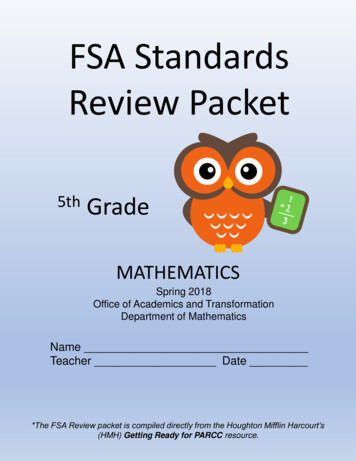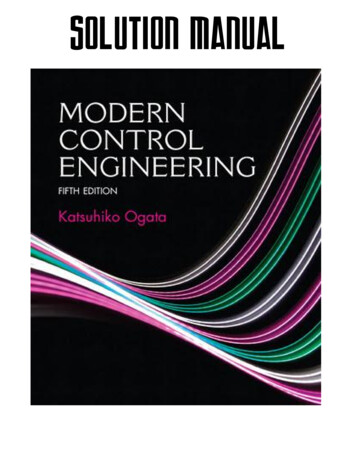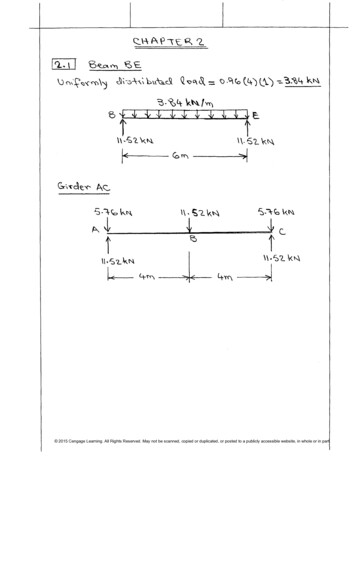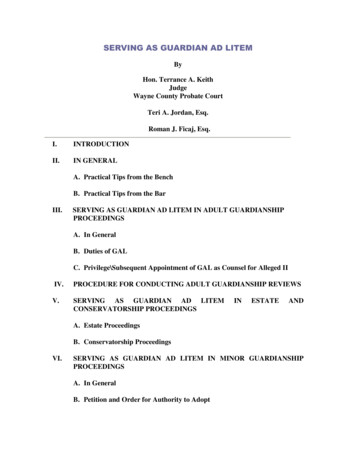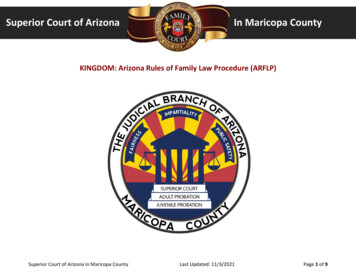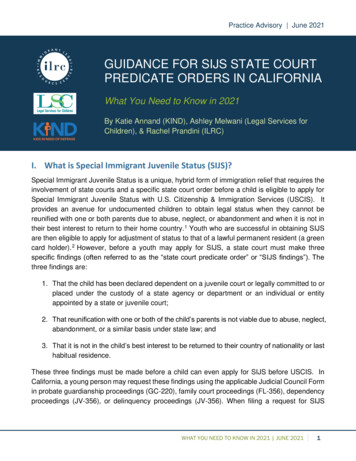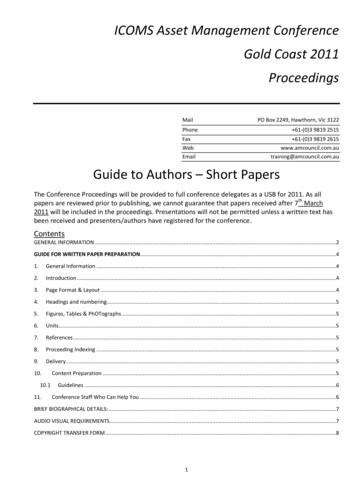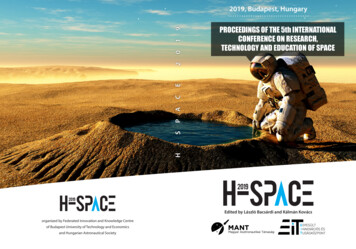
Transcription
PROCEEDINGS OF THE 5th INTERNATIONALCONFERENCE ON RESEARCH,TECHNOLOGY AND EDUCATION OF SPACEH-SPACE20192019, Budapest, HungaryEdited by László Bacsárdi and Kálmán Kovácsorganized by Federated Innovation and Knowledge Centreof Budapest University of Technology and Economicsand Hungarian Astronautical Society
Proceedings of the5 International Conference on Research,Technology and Education of SpacethFebruary 27-28, 2019, Budapest, Hungaryat Budapest University of Technology and EconomicsOrganized byFederated Innovation and Knowledge Centre ofBudapest University of Technology and EconomicsandHungarian Astronautical SocietyEditorsLászló Bacsárdi and Kálmán KovácsMANT 2019
Conference proceedingsH-SPACE 20195th International Conference on Research, Technologyand Education of SpaceFebruary 27-28, 2019, Budapest, HungaryBuilding 'K' and Building 'I'Budapest University of Technology and EconomicsMűegyetem rkp. 3., Budapest, H-1111, HungaryBME building ’I’, Hall IB 026Magyar tudósok krt. 2., Budapest, H-1117 HungaryOrganizing and Editorial BoardCo-Chairs: Dr. Kálmán Kovács, Dr. László BacsárdiMembers:Prof. József Ádám, Dr. Tibor Bálint, Ferenc Horvai,Dr. Lóránt Földváry, Prof. László Pap, Prof. Gábor Stépán,Dr. Szabolcs RózsaHonorable Patrons:Prof. Iván Almár, Prof. János Józsa, Prof. László JakabKészült a BME VIK, a BME EIT, a MANT és a KKMtámogatásával.Szerkesztők: Dr. Bacsárdi László és Dr. Kovács KálmánKiadja:Magyar Asztronautikai Társaság1044 Budapest, Ipari park u. 10.www.mant.huBudapest, 2019Felelős kiadó: Dr. Hirn Attila főtitkár Minden jog fenntartva.A kiadvány még részleteiben sem sokszorosítható, semmilyenmódon nem tehető közzé elektronikus, mechanikai, fotómásolatiterjesztéssel a kiadó előzetes írásos engedélye nélkül.ISBN 978-963-7367-18-2
WELCOME from the Organizing CommitteeWelcome to the 5th edition of our H-SPACE conference series!We are happy to welcome you at the 5th International Conferenceon Research, Technology and Education of Space. Special welcome to those participants who join the H-SPACE conference forthe first time.The event is organized by the Federated Innovation andKnowledge Centre (EIT), within the Faculty of Electrical Engineering and Informatics at the Budapest University of Technology and Economics (BME) – in cooperation with the HungarianAstronautical Society (MANT), which is the oldest space association in Hungary. The organization of the conference series started in 2015, at a time of growing opportunities arising from ESArecently granting membership to Hungary and the need for ajoint presentation of space activities pursued at BME. The selection of the date of the event pays tribute to the successful deployment to orbit and mission of the first Hungarian satellite,the Masat-1, which has been launched on February 13, 2012.This year people all over the world celebrate the greatest “smallstep for a man”, the 50th anniversary of the step of the first menonto the lunar surface. Humanity have explored the possibilitiesof life on other planets from that time, but from a very long timeago the essential conditions for life on Earth. Regarding to this,topic of this year’s conference is “Special focus on water and environment”. The agenda of the conference addresses scientific,technological and educational issues of space research andspace activities. The conference is open for both local and international professionals and provides an opportunity to showcaseHungarian scientific, technological, educational and outreachactivities, related to space.The Organizing Committee has internationally recognized members: Prof. József Ádám, Dr. Tibor Bálint, Ferenc Horvai, Prof.János Lichtenberger, Dr. Lóránt Földváry, Prof. László Pap, Prof.Gábor Stépán, Dr. Szabolcs Rózsa We are grateful for their contributions to the success of the conference.3
The conference will have five main sections: Science and Technology I-III and Education and Outreach I and II from which Science and Technology III and Educatioan and Outreach II will bea poster session with 18 great presentation.We will celebrate the 5th edition of the H-SPACE conference series with a special poster session which will start right after thekeynote presentation, held by Prof. János Józsa, the rector ofthe Budapest University of Technology and Economics.The best lectures (oral or poster) will receive the option of publishing in a journal, thus the conference contributes to the scientific progress of the researchers as a publication opportunity.This book contains the abstracts of the presentations. In thecoming months, selected full papers will be published in the official conference proceedings which will be available on our website, space.bme.hu. On this website, the proceedings and selected papers of the previous issues can be found as well.We hope you will enjoy your time in Budapest and the H-SPACEconference could help to learn about new scientific and technological results and strengthen your network.Kálmán Kovácsco-chairDirector of BME EITLászló Bacsárdico-chairVice President of MANT4
WelcomeIván Almárhonorary president, Hungarian Astronautical Societyhonorary member, International Academy of AstronauticsThe featured topic of this year’s H-Space conference is „Special focus on water and environment”. It is well known that a continuous monitoring of our environment – including thehydrosphere – is a very important task, since ithas a decisive influence on the future of life onEarth. The importance of the role of remotesensing satellites was indisputable at least inthe past four decades, because they can followall changes in the environment continuouslyand globally.Taking one step further to the investigation of other celestialbodies in the Solar System, we are more and more interested inthe alien environment observed on their surfaces by our spaceprobes. Obviously these investigations are focusing on lookingfor water as probably a necessary condition of life everywhere.Mars, Europa, Enceladus and Titan are the most important targets at present in the Solar System.Finally we are approaching a possibility to investigate also thesurface environments of extrasolar planets not very far fromEarth. Water vapor in the spectrum of the atmosphere of an exoplanet might indicate the presence of oceans and life on its surface; environmental peculiarities, on the other hand, can betechnosignatures pointing out an advanced technical civilization.5
PROGRAMIn this program, the affiliation of the first author is listed.February 27, WednesdayLocation: Building K, first floor, Saloon room14:00 GreetingsLászló Bacsárdi, Vice President of MANT, co-chair of theOrganizing Committee14:05 Discussion:From Moon landing to Mars landing (in Hungarian)Participants:Iván Almár, Honorary President, Hungarian Astronautical SocietyAndrás Sik, Vice President, Hungarian Astronautical SocietyModerator:Előd Both, President, Hungarian Astronautical SocietySession Chair: Kálmán Kovács15:00 Opening ceremonyJános Józsa, Rector, Budapest University of Technologyand EconomicsOrsolya Ferencz, Ministerial Commissioner, Ministry of ForeignAffairs and TradeElőd Both, President, Hungarian Astronautical SocietyKálmán Kovács, President, BME Space Forum15:15 Keynote presentationOn the hydrologic Impacts of Climate ChangeJános Józsa, Rector, Budapest University of Technologyand Economics15:40 One minute madness (Session Science and Technology IIIand Education and Outreach II)Poster authors present their work in 1 minute16:00 Poster session with coffee break6
Session Chair: Lóránt Földváry16:45-18:30: Technical presentations – Session Science andTechnology IRadio interferometry for the study of Jupiter's icy moonsSándor FreyKonkoly Observatory, MTA Research Centre for Astronomy andEarth Sciences, HungaryDetermination of 3D surface deformation for the 2018 Oaxacaearthquake using INSARGergely László and Lóránt FöldváryInstitute of Geoinformatics Alba Regia Technical Faculty,Óbudai University, HungaryESA perspective on lunar surface explorationMátyás HazadiEuropean Space Agency, The NetherlandsSatellite Fading Classification with Artificial Intelligence for 5GBoldizsár Márton and László Csurgai-HorváthDepartment of Broadband Infocommunications andElectromagnetic Theory, BME, HungaryInvestigation of stochastic disturbances in satellite connectedterrestrial millimetre wave wireless mesh networkJános Z. BitóDepartment of Broadband Infocommunications andElectromag netic Theory, BME, HungaryQuantum Tracking a Dataset – a New Application of QuantumCryptographyMáté Galambos and László BacsárdiDennis Gabor College, HungaryThe RADCUBE project and beyond – Cosmic RadiationMonitoring CubeSat missionDorottya Milánkovich, Zoltán Kovács, Gábor Marosy andBalázs ZáboriC3S Ltd., Hungary7
February 28, 2019, ThursdayLocation: Building I, ground floor, IB.026.9:00 Welcome coffeeSession Chair: László Csurgai-Horváth9:45 Keynote presentationRecent dosimeter developments for human spaceflight at theCentre for Energy Research, Hungarian Academy of SciencesAttila Hirn, MTA Centre for Energy Research, Hungary10:05-11:35 Technical presentations – Session Science andTechnology IIUV Spectrophotometric Time Series Analysis of the Herbig AeStar HD 163296Gerard M. Williger, Anna Vankó, Péter Ábrahám, Carol A. Gradyand Ágnes KóspálUniversity of Louisville, KY, USAStudying the MART tomography approach under severe weatherconditionsYuxiang Yan, Wusheng Hu, Ildikó Juni and Szabolcs RózsaSchool of Transportation, Southeast University in China, ChinaTransmission rates of lightning discharges into whistlersDávid Koronczay, János Lichtenberger and Orsolya FerenczEötvös Loránd University, HungaryExploitation of Sentinel-1 SAR data for studying geodynamic,tropospheric and ionospheric processesIstván Bozsó, Eszter Szűcs, László Bányai andViktor WesztergomGeodetic and Geophysical Institute, MTA Research Centre forAstronomy and Earth Sciences, HungaryA wide swath of Sentinel-based deformation monitoringapplications in HungaryPéter Farkas, Gyula Grenerczy and Sándor FreyGeoSentinel Ltd., HungaryDeveloping Balloon-Borne Payload for Remote SensingApplicationsZsófia Bodó and Bence GóczánSimonyi Károly College for Advance Studies, BME, Hungary11:35- 11:50 Break8
11:50-11:55: Opening of the Education and OutreachSessionLászló Jakab, DeanFaculty of Electrical Engineering and Informatics, BME11:55-13:40: Technical presentations – Session Education andOutreachCoderDojo and the emergence of informal space tech educationecosystemsRadu Ticiu, Andrea Magyar and Virgiliu PopCoderDojo Timisoara, RomaniaThe Watermill-Project for Secondary SchoolsCarmen Adina Oancea and Otilia Bogdana LastunColegiul Na tional “Octavian Goga” Sibiu, RomaniaInspiring the Next Generation in the Hungarian Space CampDorottya Milánkovich and László BacsárdiHungarian Astronautical Society, HungaryThe technology of CanSats, which can involve secondary schoolstudents in spaceAndrás Illyés, Levente Dudás and András GschwindtBudapest University of Technology and Economics, HungaryThe popularization of space exploration amongst high schoolstudentsTénia Kovács, Annamária Komáromi and Andrea KirályEötvös Loránd University, HungaryThe MarsQuake Program for Hungarian High School StudentsMárta Kiszely and György HudobaGeodetic and Geophysical In stitute, MTA Research Centre forAstronomy and Earth Sciences, HungarySpace weather and Arduino meteo stationMária PetőSzékely Mikó High School Sf. Gheorghe, Romania13:40 Closing remarks9
Poster presentations (Session Science and TechnologyIII; Session Education and Outreach II)Building the First Hungarian Free-space QuantumCommunication DeviceMáté Galambos, Lászlo Bacsárdi, Zoltán Belső, Eszter GerhátnéUdvary, Győző Gódor, Sándor Imre, Zsolt Kis, István Koller,János Kornis, Zsolt Papp and Viktor ZsolczaiBudapest University of Technology and Economics, HungaryDetection of Tsunamis based on Ionospheric Satellite SignalsGergely Mindler, Márk György Fék and Bence SzendiHungaryEducational Aspects of Developing a High Altitude BalloonPlatformZsófia Bodó and Bence Góczán Simonyi KárolyCollege for Advance Studies, BME, HungaryEstimating 3D Rain Fields with Satellite Beacon MeasurementsBernard Adjei-Frimpong and László Csurgai-HorváthDepartment of Broadband Infocommunications andElectromag netic Theory, BME, HungaryEvaluation of plasma properties from ground measurements forradiation belts modelingLilla Juhász, Yoshiharu Omura, János Lichtenberger andReinhard H. FriedelEötvös Loránd University, HungaryNeutron transport simulations in lunar surface regolithSzabolcs Nagy and Dávid LucsányiPuli Space Technologies Ltd., HungaryPopularizing space-related activities in the Z-generationÁkos Gyenge and Donát TakácsBME Cosmos Society, Budapest University of Technology andEconomics, HungarySimulated Mars Rover Model Competition – 2018 and 2019 backto the MARSAttila Sipos and Pál Gábor Vizimagyarokamarson.hu, Hungary10
Simulating the effects of solar particle radiation on serum immunoglobulin N-GLYCANS by capillary electrophoresis analysisAndrás Guttman, Máté Szarka, Szabolcs Szilasi, Dániel Sárközy,Boglárka Dönczö and István Rajta,Horváth Csaba Laboratory of Bioseparation Sciences, Universityof Debrecen, HungarySmall steps towards strengthening the competitiveness in spaceresearch and technology - Space-related Education Initiative forHungaryAndrea Strádi, László Bacsárdi, András Ordasi, András Illyés,Zsófia Bodó and Dániel SzendreiHungarian Astronautical Society, HungaryStereo-vision based navigation of mobile robots in pathlessenvironmentsPejman HajipoorSharif University of Technology IranStreaming Swarms as Inter-Station and Interplanetary TransferPipesPál Gábor ViziMTA Wigner Research Centre for Physics, HungaryThermal simulations and analysis of a lunar surface payloadBars Pálfi, Dávid Lucsányi and Csaba JégerPuli Space Technologies Ltd., HungaryUltimaSpace Experiments on the ISSFlórián Vámosi and Péter PósaMihály Táncsics Grammar School of Kaposvár HungaryWhy Astrophotography is the Best Promotion for SpaceExploration and Astronomy?Péter Feltóti, László Francsics and Flórián VámosiHungarian Astrophotographers' Association, Hungary11
Table of ContentOn the hydrologic Impacts of Climate Change – János Józsa . 15Recent dosimeter developments for human spaceflight at theCentre for Energy Research, Hungarian Academy of Sciences– Attila Hirn . 16A wide swath of Sentinel-based deformation monitoring applicationsin Hungary - Péter Farkas . 19Building the First Hungarian Free-space QuantumCommunication Device – Máté Galambos . 20CoderDojo and the emergence of informal space tech educationecosystems – Radu Ticiu. 22Detection of Tsunamis based on Ionospheric Satellite Signals– Gergely Mindler . 24Determination of 3D surface deformation for the 2018 Oaxacaearthquake using InSAR – Gergely László . 25Developing Balloon-Borne Payload for Remote Sensing Applications– Zsófia Bodó . 27Educational Aspects of Developing a High Altitude Balloon Platform– Zsófia Bodó . 29ESA perspective on lunar surface exploration – Mátyás Hazadi . 31Estimating 3D Rain Fields with Satellite Beacon Measurements– Bernard Adjei-Frimpong. 33Evaluation of plasma properties from ground measurements forradiation belts modeling – Lilla Juhász . 35Exploitation of Sentinel-1 SAR data for studying geodynamic,tropospheric and ionospheric processes – István Bozsó . 37Inspiring the Next Generation in the Hungarian Space Camp– Dorottya Milánkovich . 38Investigation of stochastic disturbances in satellite connectedterrestrial millimetre wave wireless mesh network – János Z. Bitó . 40Neutron transport simulations in lunar surface regolith– Dávid Lucsányi . 42Popularizing space-related activities in the Z-generation– Ákos Gyenge . 44Quantum Tracking a Dataset – a New Application of QuantumCryptography – Máté Galambos . 4612
Radio interferometry for the study of Jupiter's icy moons– Sándor Frey . 48Satellite Fading Classification with Artificial Intelligence for 5G– László Csurgai-Horváth . 50Simulated Mars Rover Model Competition – 2018 and 2019back to the MARS – Pál Gábor Vizi . 52Simulating the effects of Solar particle radiation on serumimmunoglobulin N-glycans by Capillary Electrophoresis analysis– András Guttman . 54Small steps towards strengthening the competitiveness in spaceresearch and technology - – Andrea Strádi . 56Space weather and Arduino meteo station – Mária Pető . 58Stereo-vision based navigation of mobile robots in pathlessenvironments – Pejman Hajipoor. 59Streaming Swarms as Inter-Station and Interplanetary TransferPipes – Pál Gábor Vizi . 61Studying the MART tomography approach under severe weatherConditions – Wusheng Hu . 63The MarsQuake Program for Hungarian High School Students– Márta Kiszely . 65The popularization of space exploration amongst high schoolstudents – Ténia Kovács . 67The RADCUBE project and beyond - Cosmic Radiation MonitoringCubeSat mission – Dorottya Milánkovich . 69The technology of CanSats, which can involve secondary schoolstudents in space – András Illyés . 70The Watermill-Project for Secondary Schools– Carmen-Adina Oancea . 72Thermal simulations and analysis of a lunar surface payload– Dávid Lucsányi . 74Transmission rates of lightning discharges into Whistlers– Dávid Koronczay . 76UltimaSpace Experiments on the ISS – Flórián Vámos . 78UV Spectrophotometric Time Series Analysis of the Herbig AeStar HD 163296 – Gerard M. Williger . 80Why Astrophotography is the Best Promotion for SpaceExploration and Astronomy? – Flórián Vámosi . 8213
KEYNOTE14
On the hydrologic Impacts of Climate ChangeDr. János JózsarectorBudapest University of Technology and Economics, HungarySeveral aspects (causes and impacts, threats and disasters) ofclimate change have been investigated in the last few decades.In the paper the focus is put on some global and local hydrologicphenomena in that respect. Hydro-science and engineering related research activities at the Faculty of Civil Engineering of theBudapest University of Technology and Economics apply numerous airborne and space technologies in the investigation of e.g.the data of satellite measurements in high atmosphere andimages of remote sensing based on drones as well as on satellites. The paper gives a number of examples of such relevanthydrologic phenomena including the ones with features seriously affected by climate change.Keywords:hydrology, climate change, aerial/space/satellite technology15
Recent dosimeter developments for humanspaceflight at the Centre for Energy Research,Hungarian Academy of SciencesAttila Hirnhirn.attila@energia.mta.huCentre for Energy Research, Hungarian Academy of Sciences,HungaryThe dosimeter system Pille was developed in the predecessor ofthe Centre for Energy Research, Hungarian Academy of Sciences(MTA EK). The latest version, Pille-ISS, has been regularly usedon board the International Space Station (ISS) for dose monitoring at different locations of the Russian Segment and for personal dosimetry during Extravehicular Activities (EVA) since 2003.The system is based on thermoluminescent (TL) technique andconsists of a set of dosimeters and a reader. The dosimeters contain CaSO4:Dy as TL material integrated with their individualheater and a memory chip. After exposure, the dosimeters areread out automatically by inserting them into the reader andturning them [1, 2].The Pille-ISS dosimetry system is easy to use and has proved itsstability and reliability during the last one and a half decade.The measurement results processed by MTA EK and the Institute of Biomedical Problems, Russian Academy of Sciences (IBMPRAS) showed that due to the shielding of the case and the holderpart of the dosimeter the dose values might be underestimated.This can be the case for dose measurements during EVAs at higher geomagnetic latitudes.The Russian space radiation safety standards define dose limitsfor critical organs. During EVA, eye lens and skin are the mostvulnerable because of their relatively thin (self)shielding. As thecurrent dosimeter construction does not allow the measurementof eye lens and skin doses during EVA, at the moment experts ofthe radiation safety service of IBMP RAS use only estimations.The modernized Pille-ISS dosimeters significantly reduce theshielding of the TL material. This modernization allows to measure skin and eye lens doses during EVA. The shielding reductionwill allow to take into account dose increases from electron flu-16
xes of the Van Allen radiation belts. The modernized Pille-ISSdosimeters are planned to be used also for measurements insidean anthropomorphic phantom (Matroshka-III) on board the ISS.In another phantom experiment, the MATROSHKA AstroRad Radiation Experiment (MARE) on NASA’s first exploration mission(ORION Exploration Mission 1, ORION EM-1), our research group will provide passive dosimeter package comprising TL andnuclear track etch detectors to be used inside a phantom duringthe flight to estimate the dose to female astronauts to futuretrips to the Moon. Some preliminary information on this projectwill be also given in the lecture.Keywords:space dosimetry, human spaceflight, Pille, ISS, Orion EM-1References:[1] Fehér, I., Deme, S., Szabó, B., Vágvölgyi, J., Szabó, P.P.,Csőke, A., Ránky, M., Akatov, Yu.A. A new thermoluminescentdosimeter system for space research. Adv. Space Res 1:61-66,1981[2] Apáthy, I., Akatov, Yu.A., Arkhangelsky, V.V., Bodnár, L.,Deme, S., Fehér, I., Kaleri, A., Padalka, I., Pázmándi, T., Reitz,G., Sharipov, S. TL dose measurements on board the Russiansegment of the ISS by the “Pille” system during Expedition-8, -9and -10. Acta Astronaut 60:322-328, 200717
ABSTRACTS18
A wide swath of Sentinel-based deformationmonitoring applications in HungaryPéter Farkas*, Gyula Grenerczy, Sándor Frey*farkas.peter@geo-sentinel.huGeo-Sentinel Ltd, HungarySentinel-1 satellites of EU’s Copernicus Programme provide Cband synthetic aperture radar (SAR) data for both orbits, every 6days, as a service. This can be used for many applications, including deformation monitoring of natural hazards and infrastructure. Permanent Scatterer Interferometry (PSI, PSInSAR) isone of the most advanced methods for long-term deformationmonitoring using satellite radar data. It provides motion historytime series for millions of points with mm/yr or better accuracy,that is a unique ability, incomparable to any other geodeticmethods. On the other hand, surface deformation and motion orstability of various buildings and infrastructure elements couldbe important for many fields, including oil and gas, mining industry, civil engineering, disaster management, etc. These satellite radar-based deformation measurements give decision makers valuable information for investments, maintenance andsafety aspects.We present examples from our studies in Hungary, particularlytwo ongoing research projects. One focuses on improvinglowland hydrological hazard assessments using Sentinel data,investigating the effects of subsidence on floods and inland excess water. The other is a feasibility study for health assessmentand maintenance support of large-scale linear infrastructuresystems, e.g. roads, railways and power lines. Their commonfeature is that they both exploit the large spatial and temporalcoverage of Sentinel-1 satellites as well as the high accuracy andreliability of the PSI method. Beside these couple of examples ofuseful applications for the industry and the society, based onthe unprecedented data flow of Sentinel-1, many new possibilities are waiting for exploration and continuous monitoring willalso be inevitable where it matters mostKeywords: Sentinel-1; PSInSAR; deformation ��——————* corresponding author19
Building the First Hungarian Free-spaceQuantum Communication DeviceMáté Galambos*1, László Bacsárdi1, Zoltán Belső1,Eszter Gerhátné Udvary1, Győző Gódor1, Sándor Imre1,Zsolt Kis2, István Koller1, János Kornis1, Zsolt Papp1,Viktor Zsolczai1galambos@mcl.huBudapest University of Technology and Economics, BudapestMTA Wigner Research Center for Physics, BudapestIn 2017, Hungary has started a quantum technology flagshipproject. The project is 4-year-long with a budget of roughly 10million euros. One of the goals of this flagship project is to realize secure quantum communications. The national consortiumworking on the project has several members from various institutes including Ericsson Hungary, Nokia Bell Labs, BHE BonnHungary Ltd (a Hungarian aerospace company) as well as fromacademia and research institutes.In the past years, we built the first Hungarian fiber-based Continuous Variable Quantum Key Distribution (CV QKD) device.Building on this experience, one of the current tasks is to achieve entanglement-based free-space quantum key distributionwith a potential application in the satellite domain.In preparations for these experiments, we analyzed the opticalproperties of atmospheric free-space channels. We have developed a mathematical model of loss for quantum-based satellitecommunication. Our model is quasi-classical and it is based onGaussian beam propagation in the atmosphere. It takes into account several factors: the atmospheric losses due to molecularand aerosol extinction, technological limitations such as detector efficiency and photon production efficiency and it analyzes the effect of pointing error and beam spreading given a certain detector mirror size. We compared predictions of the modelwith experimental results, and a computer program based onthe model is now ��——————* corresponding author20
On the experimental side, we have created and tested anentangled photon pair source at 850 nm wavelength based on athin β-Barium borate (BBO) crystal pl te, using Type I phasematching condition. We tested this photon source in free spaceover short distances and successfully detected coincidences between the photon pairs.The research is connected to COST Action CA15220 QuantumTechnologies in Space. The research was supported by the National Research Development and Innovation Office of Hungary(Project No. 2017-1.2.1-NKP-2017-00001).Keywords:free-space, quantum key distributionReferences:[1] J. Yin, et al., “Satellite-based entanglement distribution over1200 kilometers”, Science, Issue 6343, Volume 356,pp.: 1140–1144. (2017)[2] A. K. Majumdar, J. C. Ricklin, “Free-Space LaserCommunications Principles and Advances”, Springer, 2008,ISBN 978038728652521
CoderDojo and the emergence ofinformal space tech education ecosystemsRadu Ticiu*1, Andrea Magyar2, Virgiliu Pop3radu.ticiu@gmail.com, andream@banatit.ro, virgiliu.pop@rosa.ro1,2CoderDojo Timișoara, Romania, 3Romanian Space AgencyThe present and future of education is one of the most discussed and disputed topics nowadays, in both developed and developing countries on both officials' and laymen's levels. Variouseducational system models successfully instaured in places fromNorthern Europe to South-Eastern Asia are analysed and evaluated as potential panacea for old and currently persisting societal problems. An emphasis on a higher weight for the STEMcomponent of the new education approaches looks like a constant in countries focusing on gaining/retaining a better positionin economic competitiveness or innovation nations' ranking.Offering a more prominent role to STEM in K12 educationallandscapes is done more and more often by including programming in the K12 compulsory curricula, but from political decision to the full implementation of the newly defined conceptsin the formal educational systems, there are long and perilousroads.In the context of the inertial character of the formal educationalsystem, confronted with lack of vision, financial resources, infrastructure and needed staff, eroding the enthusiasm and interestof both students and parents, there are notable evolutions resulting in setting up and functioning of informal, free-to-attend,non-profit education initiatives.Th
The conference will have five main sections: Science and Tech-nology I-III and Education and Outreach I and II from which Sci-ence and Technology III and Educatioan and Outreach II will be a poster session with 18 great presentation. We will celebrate the 5th edition of the H-SPACE conference se-




